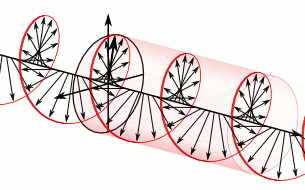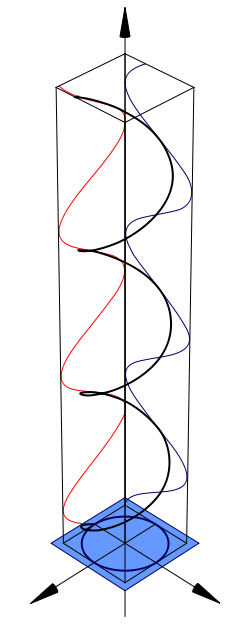User:Dave3457/Sandbox/Circular polarization Introduction

In electrodynamics, circular polarization[2] of an electromagnetic wave is a polarization where the tip of the electric field vector, at a fixed point in space, describes a circle as time progresses. (Refer to animation). If the wave is frozen in time the electric field vector describes a helix along the direction of propagation. Circular polarization is a limiting case of the more general condition of elliptical polarization. The other special case is the easier-to-understand linear polarization.
Remember to delete this sample reference[1]
References remember to delete this[edit]
- ^ a b For the handedness conventions refer to the well referenced section Left/Right Handedness Conventions
- ^ Polarization is also spelt polarisation with and “s” “British spelling of polarization” discussion .
British spelling of circular polarization[edit]
I removed the bracketed note about the British spelling of polarization which read “In electrodynamics, circular polarization (also circular polarisation) of electromagnetic radiation is a polarization such that ….” Instead I just included a reference. I don’t know about anyone else but I can’t help but feel the bracketed note is a major distraction for the reader in a sentence that is very important and it is all ready very concentrated with more important information. It doesn’t help that the spellings are so close and an “s” looks a lot like a “z”. I know personally that when I first read, it completely threw me off. The alternative British spelling of polarization is already noted in the first sentence of the Polarization article and I’m not sure that isn’t enough. Ruining the flow of such an important sentence seems to be a very high price to pay for such a thing and including it the way it was included doesn’t serve the British people any more than anyone else given its distractive nature.
The ratio of Google hits between "circular polarization" and "circular polarisation" is 5:1 and so it can be argued that it should mentioned more prominently, however I don’t believe such a high price has to be paid. Given the below comment called Caution to those spelling polarization with an “s” it could be argued that more than a footnote is in order to warn people who are using search engines to research the subject, however, again, I think the first sentence is jammed with enough information as it is.
Caution to those spelling polarization with an “s”[edit]
In this computer age works created by people using the minority spelling will not show up in search results as often as those who use the majority spelling. For example when you Google “polarization” with a “z”, “polarisation” with an “s” shows up in the search results, however when you Google “circular polarization” with a “z”, “circular polarisation” with an “s” is not included in the results. So webpages and any books converted to pdf that use that spelling are not found by the majority of people in such an instance.
Also many search engines don’t even search “polarisation” with an “s” when “polarization” with a “z” is searched. For example, works in Wikicommons that are titled using the “s” spelling only show up in the search results if they are in the “polarization” with a “z” category. And then they are lower on the list than they otherwise would be. It does not search both versions.
Xxxxxxxxxxxxxxxxxx
Old version[edit]

(as seen from the receiver)
This article may be too technical for most readers to understand. (February 2010) |
In electrodynamics, circular polarization (also circular polarisation) of electromagnetic radiation is a polarization such that the tip of the electric field vector, at a fixed point in space, describes a circle as time progresses. The electric vector, at one point in time, describes a helix along the direction of wave propagation (see the polarization article for pictures). The magnitude of the electric field vector is constant as it rotates. Circular polarization is a limiting case of the more general condition of elliptical polarization. The other special case is the easier-to-understand linear polarization.
Circular (and elliptical) polarization is possible because the propagating electric (and magnetic) fields can have two orthogonal components with independent amplitudes and phases (and the same frequency).
A circularly polarized wave may be resolved into two linearly polarized waves, of equal amplitude, in phase quadrature (90 degrees apart) and with their planes of polarization at right angles to each other.
